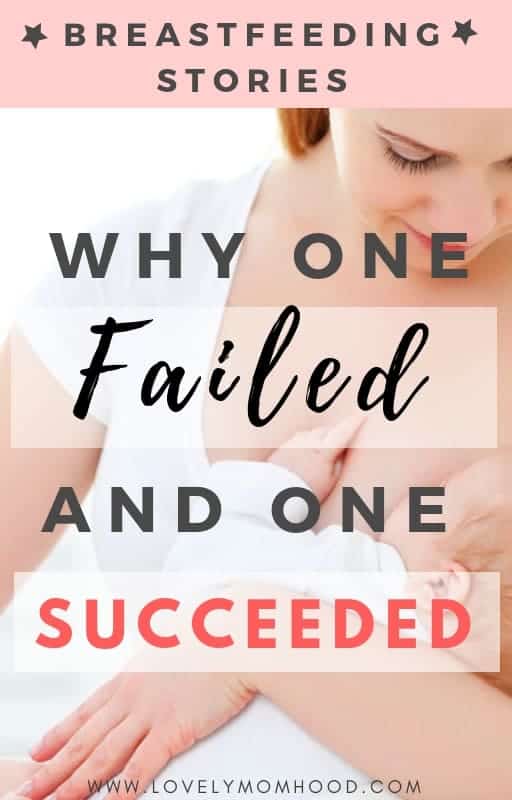My breastfeeding Stories: Why One Failed and One Succeeded (Tips and Takeaways)
Breastfeeding stories are meant to inspire and motivate you to breastfeed successfully.
After all, “breast is best,” right?
Well, it depends.

Listening to and reading about other moms’ breastfeeding stories helps you understand the immense emotional and physical investment that goes into this rewarding yet challenging phase of motherhood.
But what’s more, it teaches you a humble lesson of compassion, empathy, and solidarity.
Breastfeeding stories also give you an insight into the different struggles and successes of breastfeeding moms worldwide.
It is with that sense of empathy that I share my breastfeeding stories with you in the hopes that they will help you, motivate you, and encourage you to embrace your own breastfeeding journeys as they come.
Once you read both breastfeeding stories, we will review some tips and takeaways.
This will, in turn, help you avoid some breastfeeding mistakes and apply some successful breastfeeding tips to your own journey.
My Breastfeeding Stories: Why One Failed and One Succeeded

* This post may contain affiliate links. Click here for more info.
The Backstory
My husband and I have two children.
I thought I had everything I needed to succeed when I was pregnant with my son (first child), during motherhood and breastfeeding.
After all, I am a nurse with a good knowledge base about the human body and pregnancy as a whole.
I had also attended my birthing hospital’s breastfeeding class and I have seen other moms breastfeed throughout my life.
But boy, was I wrong…
Although breastfeeding knowledge is extremely important for a higher success rate of long-term, successful breastfeeding, many other factors play a role.
Next, I will walk you through my breastfeeding stories.
After that, we will go over what went wrong and how to prevent it. As well as what went right and how to implement it.
That way, you can be more equipped when your time to breastfeed comes.
Attempt #1: A Failed Breastfeeding Story

Birthing Story
He was born naturally on his due date after my water broke the day before while walking around the neighborhood.
After 45 minutes of pushing, hemorrhoids, and internal stitches, I made sure I couldn’t sit down for a solid two weeks.
My perfectly healthy 8 lb 4oz little boy was born.
He was immediately taken to the warmer as they suspected meconium aspiration.
Thankfully, that wasn’t the case.
However, it was enough to rock the foundation of the “expectations” I had set for myself.
Related: The Ultimate Postpartum Care Kit (All-Natural and Non-Toxic)
Failed Breastfeeding Story
Breastfeeding started when we received the clear of no meconium aspiration 20 minutes later.
Latching took a while, but baby and I both seemed to have figured it out eventually… or so I thought.
He was sent home with a bili blanket for two days in an attempt to reduce elevated bilirubin levels.
Thankfully, it worked. But not without leaving another mark on my already overwhelmed and bruised perspective.
The first few days home from the hospital were rough.
I couldn’t sleep, not even when my husband offered to watch the baby. I felt helpless, exhausted, and overwhelmed.
Although I had somewhat of an idea of what to expect after giving birth, the reality of it was much more challenging than I was prepared for.
We reached out for help, and a breastfeeding consultant gave us a few pointers, which helped improve some of our breastfeeding problems.
Breastfeeding went on for a few more weeks because of the guilt I felt about stopping.
But I wasn’t happy.
I wasn’t enjoying the breastfeeding process of motherhood, for that matter.
At four weeks postpartum, I developed a clogged duct and a few nipple blisters that forced me to only breastfeed from one breast for a few days and exclusively pump from the other while it healed.
Consequently, we switched him to formula after a few more days of what seemed to be an eternity.
My heart sank a little. I cried a few days following the switch to formula because of the inability to feed my child the way “nature” had intended me to.
Later, of course, I realized that a happy and healthy baby goes far beyond breastmilk and that I shouldn’t feel guilty for giving it my best shot.
Attempt #2: A Successful Breastfeeding Story

We discovered we were pregnant with our second child when our son was over two years old.
Coming into it, I knew I wanted to give breastfeeding another try.
I was confident this time about what I had learned from my previous experience and a few other resources and breastfeeding tips I had gathered along the way.
To our amazement, we also found this second baby would be a girl (yay!) and that she would have the same due date as her brother!
Just like her personality today, she wasn’t going to settle for that.
Share her birthday? NEVER.
So, she made her grand entrance the day after her due date all on her own.
BIRTHING STORY #2
Contractions started two days before her due date, but she held her own until the day after her due date, when I finally caved in and headed to my birthing hospital.
My water broke on its own at triage. Contractions got strong and fast, quickly!
After three days of contractions, the epidural seemed like a good option, so I had it.
But, the epidural didn’t do much of its job so I felt almost everything.
So much so that less than 4 hours after my water broke, I felt an “I need to poop” sensation, and I knew the time had come.
My husband alerted the nurse, I was rechecked for dilatation, and that was it… it was go time!
With one minor problem… The doctor was 10 minutes away, so I was told not to push.
What?!?
Had it not been apparent that this child would have her way much before conception?
Sure enough, as the doctor walked in through the door, my daughter’s head was already visible. And as she said her first set of “OK, PUSH!” repetitions, my daughter was born.
She was placed in my chest immediately.
It was utter bliss.
No intervention, no commotion, no rush. Just her and I for what felt like an eternity.
The nurse patted her down a little bit more next to me, suctioned her, and ensured she was ok. After that, she was placed back in my arms to start our breastfeeding journey.
This time, I felt more confident, more prepared (both physically and mentally), and more at ease.
Because of the fast labor, my body didn’t feel as depleted or overworked. Hemorrhoids weren’t as bad, and no stitches were necessary.
I didn’t feel depressed or overwhelmed. Something I prayed so hard for not to happen again. God made sure I was taken care of this time, that’s for sure!
What a relief!
Our breastfeeding journey lasted nine months as a result of a few other factors, but I was incredibly content with that!
Successful Breastfeeding Story
She developed baby eczema at two months old. As instructed by my pediatrician, I removed all dairy from my diet and applied Vanicream Cream twice a day, and I began to see a complete turnaround.
That did the trick. A week later, she was eczema-free and has been to this day.
I was able to breastfeed her for 10 months exclusively.
Tips and Takeaways
As you probably already noticed, there were a lot of factors that took place in both breastfeeding stories—some that were in my control and some that were not.
In either instance, there were many things I could have done to have perhaps ensured a better outcome.
Next, we’ll cover what I failed and what I could have done to correct it. Then, we will see what I did successfully and why it worked out in my favor.
Related: 13 Postpartum Care Tips and Instructions to Heal Faster After Vaginal Delivery
THINGS I FAILED TO DO AND HOW TO CORRECT THEM
ATTITUDE
I allowed a few things that didn’t go according to plan to get me discouraged and overwhelmed.
Granted, postpartum hormones are often uncontrollable. But having a more optimistic outlook would have probably made a difference.
I would have saved myself a lot of disappointment had I embraced and owned my labor process instead of getting so caught up in what I “expected things to be like.”
The birthing and postpartum recovery process was hard for me during my first pregnancy. Had I had the proper resources at my disposal I think that could have made a difference.
By my second pregnancy, these were all things I worked on mentally and emotionally.
Changing my perspective allowed me to see things differently the second time around, and it helped set the foundation for a healthier breastfeeding journey.
BREASTFEEDING EDUCATION
Although I attended a breastfeeding class, it wasn’t practical for me.
After all, talking about breasts and cracked nipples in a classroom with other women (and men) was not my idea of a good time.
Learning about breastfeeding in a more intimate and paced environment would have made an enormous difference.
A great resource is The Ultimate Breastfeeding Online Classes by Stacey Stewart. Stacey is a Certified Lactation Educator through CAPPA, a mom of 3, and the founder of Milkology.
I had a breast pump but didn’t know how to use it effectively, which could have helped in alleviating the clogged duct.
Milkology also has a great course that navigates through how to pump effectively along with other important information.
When we got home from the hospital, positioning and latching were a constant struggle.
In turn, my nipples weren’t happy.
Again, this is something I could have learned more about.
However, I knew the baby was getting enough milk because of his wet diaper count and weight increments in his prenatal visits.
I wasn’t able to heal my nipple blister faster because I didn’t have the proper resources.
BREASTFEEDING ESSENTIALS
Had I known about nipple shields and how to use them effectively, I would have given my nipples a better chance at recovering faster.
THINGS I DID THAT WERE SUCCESSFUL

OPTIMISTIC ATTITUDE
I noticed an incredible improvement the second time in how I approached breastfeeding.
I was more optimistic, had a better outlook on things, and didn’t create expectations that were outside my control.
Instead, I listened to my body, followed my daughters’ cues, and put into practice everything I had learned.
BREASTFEEDING AND BIRTHING EDUCATION
Education played a crucial role the second time around.
Instead of “winging it” and looking for answers after something had already gone wrong, I knew what to do to prevent those things from happening.
In addition, if something came up that I needed help with, at least I knew where to find the best answer.
Best breastfeeding resources I’ve come across:
Best Online Natural Hospital Birthing Class:
BREASTFEEDING ESSENTIALS
In addition to education, there were some breastfeeding essentials I couldn’t have done without:
- Boppy Pillow: I LOVE this pillow. It allowed me to breastfeed comfortably, and my kids have used it through all their milestones. They use their Boppy as floor cushions in their play area.
- Breast Pump: Having a great breast pump and knowing how to use it was a game-changer. My Medela Pump was a blessing in my life, and I am happy to say that it has also been a blessing to the lives of others. Ever since we purchased it, it has gone around through our circle of friends helping mommies continue their breastfeeding journey once they have gone back to work.
- Nipple Cream: After my first experience, taking care of my nipples was a priority. So, having an effective, organic, and safe-to-use nipple cream was a must!
ASKED FOR HELP
Contacting a breastfeeding consultant was the best thing I could have done at the time.
She gave me insight on things I would have probably never figured out on my own and gave me clarity about things I needed to do differently moving forward.
My mistake, however, was not reaching out to her again after the initial consultation.
Related article: 13 Must-Read Breastfeeding Tips for New Moms (to help keep you sane!)
Conclusion
Breastfeeding is hard!
The truth is that although breastfeeding IS the best thing for babies, it isn’t always suitable for every mother.
Breastfeeding isn’t something that happens with the click of a button or the flip of the switch.
Many factors (physically, mentally, emotionally, and spiritually) play a role in the success or failure of a breastfeeding journey.
Some of those things are in our control, and some aren’t… but one thing remains true:
You are lovely. You are strong. And you are MOTHER.
Breastfeeding doesn’t define you. It enhances you. You are still a great mom, whether you are granted the incredible blessing to breastfeed or whether you choose not to for other reasons.
Don’t let ANYONE guilt you into thinking otherwise.
Your motherhood journey is yours and yours alone, and it goes far beyond choosing to breastfeed.
Educate yourself, use all of your resources, and try your very best to breastfeed.
At the end of the day, as moms, that’s all we can do without a rule book.
Just try our best.
Was your breastfeeding story a successful one?
If you are pregnant, what do you hope to accomplish?
Pin it for later…




